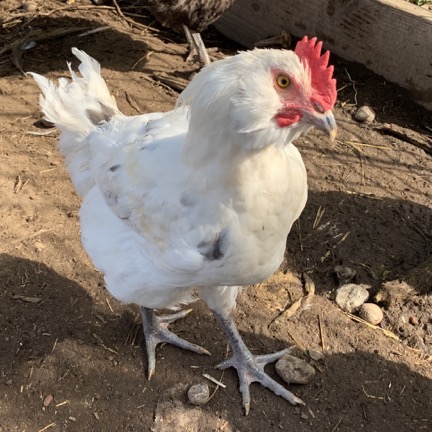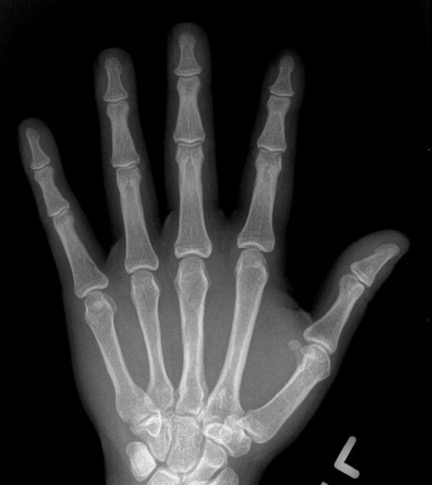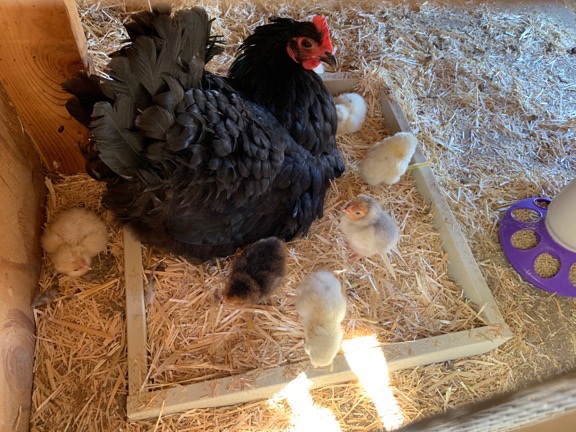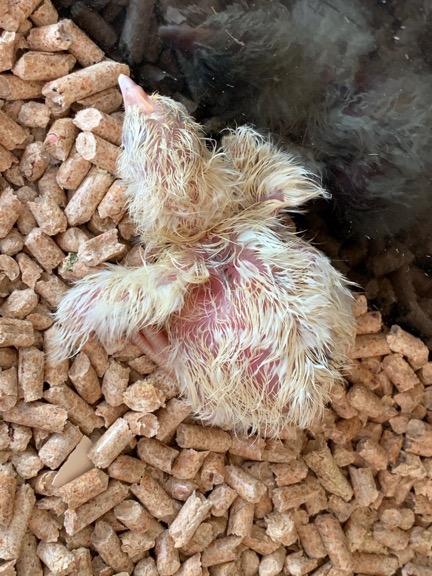Nothing is really as quiet as it seems.
“You live in a quiet place.”

Future dinner guest of honor.
That’s the first thing the hispanic man said when he got out of his small four-door sedan in my driveway. He took a step back and opened the back door where his young son was sitting in a booster seat. He’d come to get the pair of two month old roosters I’d advertised on Craig’s List for free just the day before.
I was surprised by his observation. Most people commented on the view, which can be breathtaking if you’ve never seen it from my property’s perspective. I thought about his words and said, “Sometimes.”
We worked as a team to catch the two roosters, which were both white with gray patches on their backs. They’d been hatched by my broody hen who preferred sitting on eggs to laying them. Two months after playing mom to these boys and their four broodmates, she was sitting on eggs again and already had two chicks.
He put the two roosters in a small pet carrier just large enough for a 20-pound dog.
“There’s another one in there, but I’m not sure which one it is,” I told him.
“It’s the brown one,” he said. We walked back to the fenced in area and he pointed it out. I thought he might be right. I went in and caught it easily. He put it in the carrier with the other two.
“Are you going to eat them?” I asked.
“Yes. But I might wait a few weeks for the brown one. He’s small.” He showed the carrier’s cage door to his son, who had remained patiently in the car. “Pollo,” he said.
Then he put them in the trunk, shut the lid, and drove off.
I was glad he’d be eating them. Better that then setting them to fight.
– o –
Much later, after spending time at the local airport watching the rapelling crew practice and having lunch with a friend and looking at a trailer for sale and checking on an AirBnB house I manage I got back home. I listened to the radio as I did chores.
His observation came back to me a while later when I was out on the deck, fetching a bedspread I’d hung out over the rail out there.
Even though the radio was off — I’d grown tired of listening to voices talk about the same old thing — it wasn’t that quiet. Out in the distance, I could hear a dirt bike revving its engine as it sped around on a dirt track in someone’s back yard. I could hear a dog barking. I could hear a motor — maybe a lawn mower? — down in the valley below me. If I listened hard enough, I could hear the cars on the road across the river.
I put the bedspread in the dryer and turned it on, then went back outside to see what else I could hear. The dryer through the vent. Rover the cat’s nails as they dug into the 8-inch square posts holding up my deck roof while he climbs the twelve feet to my perch. A single cricket starting its night song early.
You live in a quiet place.
I wondered where he lived and how much louder it was. Did he live near an orchard where there was always the sound of sprayers or mowers or work crews pruning or picking or working on irrigation? Did he live near a major road where there was always the sound of traffic rushing by? Did he live in a densely packed neighborhood where you could always hear some man shouting, some woman yelling, some kid screaming, some dog barking, some car with a bad muffler growling?
I remembered what it was like in Manhattan, on the overnight stays on 57th Street near First Avenue where my college boyfriend’s parents lived. Fourteen floors up in a building with a doorman and a guy would would fetch your car from the garage when you called on the house phone. Out on the tiny balcony or inside with the windows open even a crack, the sound of the city was a constant quiet roar, punctuated with car horns and sirens. It was never quiet there, just as it was never dark.
Even here there were times when it wasn’t quiet at all. In the late winter and early spring, when the temperature dipped down to the low 30s, the wind machines — two bladed fans on tall poles — would come to life, spinning their blades on rotating heads that sounded just like helicopters coming and going over the orchards around them. Sometimes they’d start as early as 11 PM and run all night long, finally shutting down an hour or so after the sun finally began warming the air around them. But how often did that happen? Four or five times in a whole year?
The orchard sprayers were a different story. They ran almost daily, usually in the morning, sometimes starting before dawn. I’d wake at 4 and go out onto my deck and look out to see their headlights among the trees. Pesticides, herbicides, anti-fungal chemicals, and who knew what else? During the day I’d see the spray like a cloud around the sprayer as it moved through the orchard. The chemicals didn’t bother me; they never traveled far. But it was the sound — a steady whine — that you couldn’t avoid. Even that was seasonal, though, and when the trees were picked, the sprayers were mostly silent.
You live in a quiet place.
Back in the chicken yard, my remaining rooster, father of the three that had left in the car trunk, crowed. Another cricket took up the evening song. A larger, closer dog barked. My roof clicked as it always does when the sun sets and the metal panels start to contract in the cooling air. A train rumbled by two miles away and then tooted its horn at a distant crossing as I knew it would.
The dryer finished its short fluff cycle and the vent sound faded. Inside my laundry room, The Samsung dryer would play Bach in simple tones before shutting off.
Was this quiet? I guess that depended on what you knew. It was quieter than Manhattan, but it wasn’t nearly as quiet as the 40 acres I used to own with my wasband at the top of a mesa 30 miles south of the Grand Canyon. Five miles from pavement, it was so quiet that you could hear the sound of a raven’s wings flapping as it flew by. It was so quiet that one morning, when I tried to turn the radio down because it seemed so loud, I discovered that the volume level was already set to 1. That was a quiet place.
I turned and went inside to finish making the bed, leaving the door to the deck open so the sounds of this quiet place could come inside.









